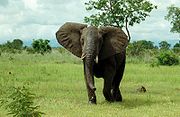Paenungulata
| Paenungulata | |
|---|---|

| |
| Top: Hyracoidea), Arsinoitherium zitteli (Embrithopoda); bottom: Asian elephant (Proboscidea), West Indian manatee (Sirenia ).
| |
| Scientific classification | |
| Domain: | Eukaryota |
| Kingdom: | Animalia |
| Phylum: | Chordata |
| Class: | Mammalia |
| Superorder: | Afrotheria |
| Clade: | Paenungulatomorpha |
| Grandorder: | Paenungulata Simpson, 1945 |
| Subgroups | |
| |
Paenungulata (from
Molecular evidence indicates that Paenungulata (or at least its extant members) is part of the cohort Afrotheria, an ancient assemblage of mainly African mammals of great diversity. The other members of this cohort are the orders Afrosoricida (tenrecs and golden moles), Macroscelidea (elephant shrews) and Tubulidentata (aardvarks).[2]
Of the five orders, hyraxes are the most basal, followed by embrithopods; the remaining orders (sirenians and elephants) are more closely related. These latter three are grouped as the
History
In 1945, George Gaylord Simpson used traditional taxonomic techniques to group these spectacularly diverse mammals in the superorder he named Paenungulata ("almost ungulates"), but there were many loose threads in unravelling their genealogy.[4] For example, hyraxes in his Paenungulata had some characteristics suggesting they might be connected to the Perissodactyla (odd-toed ungulates, such as horses and rhinos). Indeed, early taxonomists placed the Hyracoidea closest to the rhinoceroses because of their dentition.
When genetic techniques were developed for inspecting
However, a
Phylogeny
| |||||||||||||||||||||
| A cladogram of Afrotheria based on molecular evidence[6] |
Gallery
-
The rodent-like hyrax
-
A bullbush elephant
-
A manatee and her calf
-
Ocepeia, a basal species
-
Arsinoitherium, a rhino-like embrithopod
-
Desmostylus, a member of desmostylia, the only extinct order of marine mammals.
Extinct orders
Each of the extinct orders, the Embrithopoda and Desmostylia,[a] was as unique in its members' ways of making a living as the three orders that survive. Embrithopods were rhinoceros-like herbivorous mammals with plantigrade feet, and desmostylians were hippopotamus-like amphibious animals. Their walking posture and diet have been the subject of speculation, but tooth wear indicates that desmostylians browsed on terrestrial plants and had a posture similar to other large hoofed mammals.[2]
See also
- Altungulata
- Meridiungulata
Notes
- ^ a b Desmostylians, however, have been placed in Perissodactyla by a 2014 cladistic analysis,[5] and the taxonomic placement of embrithopods has also been questioned[7] though recently supported.[8]
References
- ISSN 2296-701X.
- ^ PMID 3444412. Archived from the original(PDF) on 30 June 2010. Retrieved 24 July 2010.
- ^ "One Protein Shows Elephants and Moles Had Aquatic Ancestors". National Geographic Society. 13 June 2013. Archived from the original on 17 June 2013.
- ^ PMID 17999766.
- ^ PMID 25295875.
- S2CID 46133294.
- S2CID 89418652.
- PMID 30008332.
Sources
- Kleinschmidt, Traute; Czelusniak, John; Goodman, Morris; Braunitzer, Gerhard (1986). "Paenungulata: A comparison of the hemoglobin sequences from elephant, hyrax, and manatee" (PDF). Mol. Biol. Evol. 3 (5): 427–435. PMID 3444412. Archived from the original(PDF) on 30 June 2010. Retrieved 24 July 2010.
- McKenna, M.C.; Bell, S.K., eds. (1997). Classification of Mammals above the Species Level. New York, NY: Columbia University Press. ISBN 0-231-11013-8.
- Seiffert, Erik; Guillon, J.M. (2007). "A new estimate of afrotherian phylogeny based on simultaneous analysis of genomic, morphological, and fossil evidence". BMC Evolutionary Biology. 7: 13. PMID 17999766.
- Simpson, G.G. (1945). "The principles of classification and a classification of mammals". hdl:2246/1104.
Further reading
- Gheerbrant, E. (2005). "Paenungulata (Sirenia, Proboscidea, Hyracoidea, and Relatives)". In Rose, Kenneth D.; Archibald, J. David (eds.). The Rise of Placental Mammals: Origins and relationships of the major extant clades. Baltimore, MD: Johns Hopkins University Press. pp. 84–105. ISBN 080188022X– via Google Books.
External links
- "Vertebrates: Paenungulata". Paleos.com. Archived from the original on 2008-03-13.








